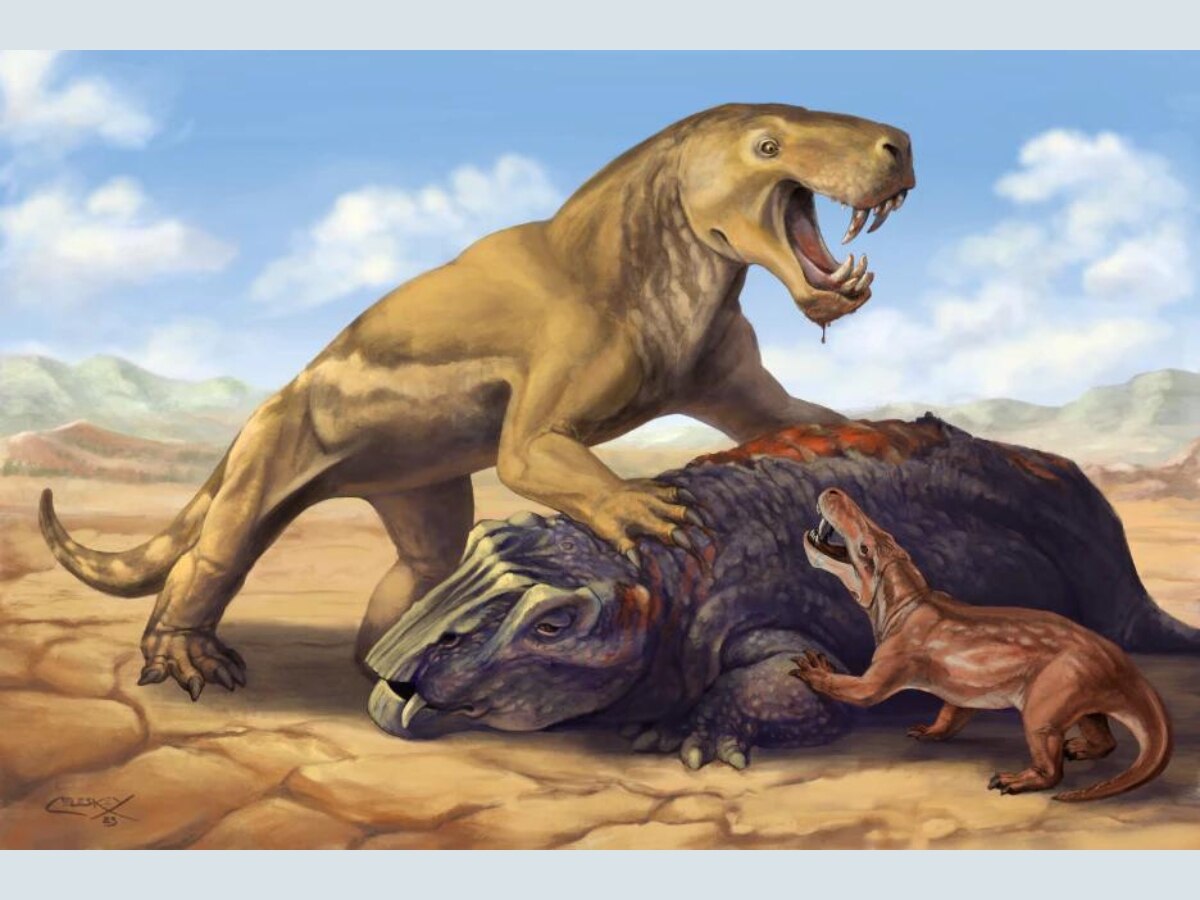Sabre-Toothed Creature Was A Top Predator Before The 'Great Dying', Its Fossils Reveal
The sabre-toothed creature, called Inostrancevia, illustrates the instability during the Great Dying. Inostrancevia struggled for dominance in the food chain prior to the mass extinction event.

A sabre-toothed creature the size of a tiger was a top predator in the period leading up to the “Great Dying", its fossils have revealed. The creature, called Inostrancevia, illustrates the instability during the Great Dying. Inostrancevia struggled for dominance in the food chain prior to the Great Dying, according to a study published May 22 in the journal Current Biology.
According to the Field Museum, a natural history museum in Chicago, Inostrancevia likely had skin like an elephant or a rhino, was vaguely reptilian in appearance, and was part of the group of animals that included modern mammals.
Eventually, the sabre-toothed creature went extinct itself.
What was the Great Dying?
The Great Dying, also known as the Permian-Triassic extinction event, was a mass extinction event which occurred about 250 million years ago. It is the most severe mass extinction event to have ever occurred, and led to the loss of up to 96 per cent of all marine species and around 70 per cent of all terrestrial species, including plants and insects, according to the Geological Society of America. This catastrophic ecosystem disruption in the late Permian period resulted in the greatest loss of biodiversity in Earth's history.
The Great Dying was the end of the Paleozoic era, and is believed to have occurred due to the emission of massive amounts of greenhouse gases into the atmosphere over a short period of time, as a result of volcanic activity at the end of the Permian period, the last period of the Paleozoic era. Therefore, climate change wiped out nine out of every ten species about 250 million years ago, and set the stage for dinosaurs. The Great Dying took around 100,000 years, and during this period, Inostrancevia migrated over 11,000 kilometres across the supercontinent Pangaea, and was a top predator, the study said.
Inostrancevia connected northern and southern hemisphere faunas
The Permian predator connected northern and southern hemisphere faunas, the authors noted in the study.

What were Laurasia and Gondwanaland?
During that era, the large northern continent, called Laurasia, and the southern continent, called Gondwanaland, were separated by an ocean called Tethys, which no longer exists today. The ancient continental mass of Laurasia in the Northern Hemisphere included North America, Europe and Asia, except peninsular India, while Gondwanaland, also called Gondwana, was the southern half of the Pangaean subcontinent which included major continental blocks of South America, Arabia, Madagascar, India, Australia, Africa, Sri Lanka, and Antarctica.
Why did Laurasian taxa migrate to Gondwana?
Since Gondwanan carnivores were becoming extinct, the influx of Laurasian taxa occurred, the study said.
Also, top predatory niches were extremely unstable during the Great Dying.
ALSO READ | Did Humans Originate From A Single Place In Africa? Study Rejects Old Theory, Presents New Timeline
Which organisms suffered major losses before the Great Dying?
The synapsids, which were the dominant terrestrial vertebrates of the Permian period, suffered major losses prior to the Great Dying. Synapsids were mammals that evolved from amniotes, a clade of tetrapod vertebrates that have an amnion for the protection of the embryo, a chorion for gas exchange, and an allantois for metabolic waste disposal.
The amnion is a membrane forming a fluid-filled cavity that encloses the embryo, the chorion is the outermost membrane around the embryo, and the allantois is an extra-embryonic membrane of reptiles, birds and mammals arising as a pouch or sac from the hindgut.
After the mass extinction event, synapsids were replaced by reptiles in the Triassic period.
Major organisms that were completely wiped out during the event
Gorgonopsians, a major group of tetrapods that were sabre-toothed, were completely eradicated by the Permian-Triassic mass extinction.
When were the largest African gorgonopsians assumed to go extinct? Is the assumption correct?
The Rubidgeinae, which were the largest African gorgonopsians, have traditionally been assumed to go extinct at the Permo-Triassic boundary, which is dated back to about 251.2 million years ago.
According to the Encyclopedia of Geology, the Permian-Triassic boundary is the point at which a specific species of fossil conodont, a Paleozoic tooth-like fossil belonging to an extinct marine animal that was a primitive vertebrate, first appeared in a geological section at Meishan in South China. The species, whose conodont appeared in the geological section, is called Hindeodus parvus, and its first appearance in the fossil beds at Meishan marks the base of the Triassic.
However, the authors said, the apparent persistence of the largest African gorgonopsians till the Permo-Triassic boundary is at odds with ecological theory indicating that top predators have high extinction risk.
Inostrancevia specimens were found in South Africa
The authors have reported gigantic specimens of the youngest known large-bodied gorgonopsians from the Permo-Triassic boundary site of Nooitgedacht 68, a farm in South Africa which contains strata that record a complete Permo-Triassic boundary. The gigantic specimens are not rubidgeine, but Inostrancevia. This taxon was previously thought to be endemic to Russia. Animals belonging to the genus Inostrancevia were up to three-and-a-half metres long, and the largest gorgonopsians to walk the Earth.
Rubidgeines were early victims of ecosystem disruption, were replaced by Inostrancevia
After a comprehensive review of the South African gorgonopsian record, the authors demonstrated that rubidgeines were early victims of ecosystem disruption preceding the Great Dying, and were replaced as top predators by Laurasian immigrant inostranceviines.
The reign of Inostrancevia was short-lived
The authors said that the reign of the Laurasian immigrant inostranceviines was short-lived.
Which organisms replaced gorgonopsians?
By the Permian-Triassic boundary, gorgonopsians were extinct, and a different group of organisms became the largest synapsid predators. These were the therocephalians, which had large teeth, and were anatomically similar to gorgonopsians, except for the fact that the former were stubbier, had thicker legs, and a smaller body.
Eventually, the therocephalians became extinct.
Inostrancevia briefly occupied the vacancy in the niche of top predators before the Great Dying
In a statement released by the Field Museum, Pia Viglietti, a research scientist at the Field Museum of Natural History, and a co-author on the new paper, said that all the big top predators in the late Permian in South Africa went extinct well before the Permian-Triassic mass extinction, and this vacancy in the niche was occupied, for a brief period, by Inostrancevia.
Viglietti explained that Inostrancevia was a gorgonopsian, which was a group of proto-mammals that included the first sabre-toothed predators on the planet.
What changed the belief that Inostrancevia were found only in Russia?
Before the new study was conducted, Inostrancevia had only ever been found in Russia. As part of the new study, Christian Kammerer, a palaeontology curator at the North Carolina Museum of Natural Sciences, was examining the fossil record of South Africa's Karoo Basin, where farm Nooitgedacht 68 is located. During the investigation, Kammerer discovered the fossils of two large predatory animals that were different from those normally found in the region. These fossils belonged to Inostrancevia.
According to the Field Museum, Viglietti explained that when the researchers reviewed the ranges and ages of the other top predators normally found in the Karoo Basin, they found an exciting detail. The rubidgeine gorgonopsians were normally found in the South African basin.
The researchers compared the ranges and ages of these creatures with the Inostrancevia fossils, and found that the local carnivores — rubidgeine gorgonopsians — went extinct quite a bit before even the main extinction event in Karoo. By the time the extinction began in other mammals, the rubidgeine gorgonopsians were gone, Viglietti said.
Inostrancevia were “canaries in the coal mine”
According to the Field Museum, the arrival of Inostrancevia from over 11,000 kilometres away, and its subsequent extinction indicates that these top predators were "canaries in the coal mine" for the larger extinction event to come.
Jennifer Both, a co-author on the paper, said in the statement that the South African Karoo Basin continues to produce critical data for understanding the most catastrophic mass extinction in Earth's history.
Evidence which suggests the extremity and instability during the Great Dying
According to the Field Museum, Kammerer said that the fact that the shifts in the groups of animals occupying apex predator roles occurred four times over less than two million years around the Permian-Triassic mass extinction underlines how extreme and unstable the crisis was. Such frequent shifts in animals occupying apex predator roles are unprecedented in the history of life on land. Even the fundamental roles in ecosystems were in extreme flux before the Permian-Triassic mass extinction, Kammerer said.
Similarities between vulnerabilities of top predators before the Great Dying, and those of current counterparts
One can draw a similarity between the vulnerability of the top predators around the Permian-Triassic mass extinction to that of their present-day counterparts.
According to the Field Museum, Kammerer, citing examples of wolves in Europe and tigers in Asia, said that apex predators in modern environments tend to show high extinction risk, and tend to be among the first species that are locally eradicated due to human-mediated activities such as hunting or habitat destruction.
He explained that wolves in Europe and tigers in Asia are species which tend to be slow to reproduce and grow, and require large geographic areas to roam and hunt prey. They are now absent from most of their historic ranges.
According to Kammerer, one should expect that ancient apex predators would have had similar vulnerabilities, and would be among the species that first go extinct during mass extinction events.
The Permian era is a parallel to the present-day scenario
Viglietti said in the statement that the study sheds new light on the Permian-Triassic mass extinction event that helped lead to the rise of the dinosaurs, and is important because it can teach us about the ecological disasters Earth is currently experiencing.
She explained that it is always good to get a better understanding of how mass extinction events affect ecosystems, especially because the Permian is a parallel to what we are going through now. The Permo-Triassic mass extinction event represents one of the best examples of what we could experience with our climate crisis and extinctions, and hence, it is important to understand what the world needs to do now and how to stop it from happening.
The authors concluded that the extinction and replacement of top predators in rapid succession at the clade level highlights the extreme degree of instability in the latest Permian and earliest Triassic. This phenomenon was probably global.







































